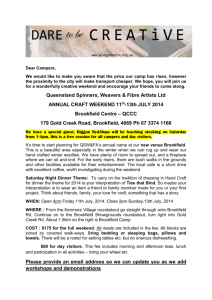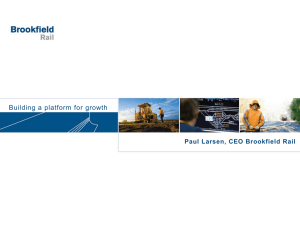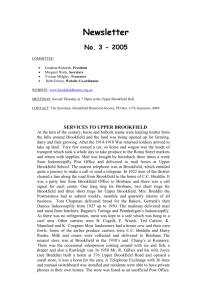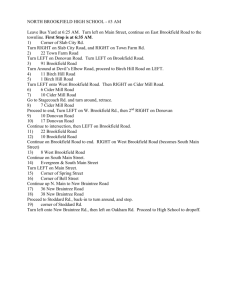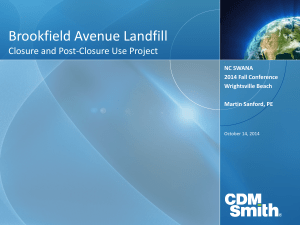Gold-mining Presentation
advertisement
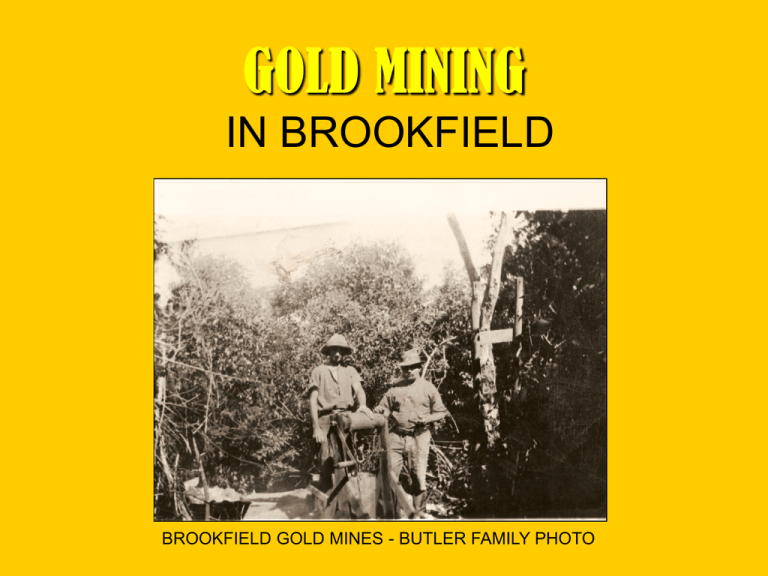
GOLD MINING IN BROOKFIELD BROOKFIELD GOLD MINES - BUTLER FAMILY PHOTO INTRODUCTION • As early as 1851, government and private enterprise encouraged prospectors to look for gold in Queensland. • In 1853, there was a flurry of gold activity around Brisbane. Possibly, Gold Creek received its name at this time. • Some gold prospecting occurred in Brookfield in 1866 and the early years of the 20th Century. • Several mines were established. • Reported findings were not very significant. OVERVIEW • Alluvial mining occurred on Gold Creek in about 1866. • In the 1920s, several mines were established namely, the Prince of Wales Mine (later renamed Acme), the Surprise Group, Eclipse Reefs, Centenary Mine, Little Wonder, Dorothy Reta and Butler’s Hope. The latter three claims were made in the 1930s, but none recorded payable gold. • At least two mining companies were formed – The Brookfield Freehold Prospectors Gold Mining Company Limited, and The Gold Creek Gold-Mining and Prospecting Company, Limited. AREA WHERE GOLD WAS DISCOVERED IN BROOKFIELD CENTENARY MINE AT BROOKFIELD 1924 REPORTED FINDINGS – In the early 1920s,The Surprise Group took 20-tonnes of stone from a 20-metre shaft, producing about 9 grains of gold per tonne. – Surprise #2 West sank several shafts from which several rich specimens were obtained by dollying. – Surprise Claim of Dart, Mattingley and party sank a 17-metre shaft beside the old Enoggera-Indooropillly Road (Boscombe Road). 8-tonnes of ore was sent to Gympie for crushing in December 1922 and yielded 8.25 ozs of gold. REPORTED GOLD DISCOVERY The Brisbane Courier, 20 June 1895, page 4 GEOLOGY • The metaphoric rocks in the Brookfield area form part of the Brisbane schist series of undetermined age. Schist is by far the most common rock, the predominating variety being biscuit shade to brown in colour and very compact. • In addition, the scrub was very thick. Mattingly and Lynch found prospecting easier where Dart’s gully had been cleared of scrub and lantana so that bananas and pawpaws could be planted. PROSPECTORS TRAVELLED LIGHT However, in Brookfield many of those who made mining claims were locals who lived near the mines or in nearby suburbs. For example, teachers at Gold Creek State School and Brookfield State School were on the list of people who had mining claims in the district. PROSPECTING FOR GOLD • Followed creeks upstream panning for signs of gold. • While amounts of gold increased, they continued moving upstream looking for signs of gold-bearing rock on creek banks. • When gold panned in the creek decreased, they would test the banks for a clue to the source of the alluvial gold. • They would dig shallow pits, regularly spaced along the creek banks, sampling surrounding rock looking for the lode (quartz bearing rock). Often the lode was visible as a shiny quartz outcrop, but in other cases it was covered with other rocks and soil. • Once the lode was located, shallow trenches called costeans were dug across the lode to determine its width, the angle at which it dipped and the direction in which it ran. These costeans also indicated where the highest gold concentrations were likely to be in the lode. • Once the prospector knew the location of the lode, he would then apply for a miner’s right in order to stake a claim. A MINER’S RIGHT A MINER WAS REQUIRED TO HAVE A MINER’S RIGHT BEFORE MARKING OUT AND WORKING A CLAIM STAKING A CLAIM With the miner’s right, the prospector was then free to stake a mining claim. This was done on two sides of each post, indicating the direction of the boundary line for each claim. The miner then submitted an application form to the local mining warden, accompanied by a sketch plan showing the locality of the claim and its relative distance from some well known place or feature. The total number of mining claims from 19211937 in Brookfield totalled 139. This number included 23 women who either shared claims with each other or with their husbands. WORKING THE CLAIM • The ore was mined from the lode by pick and shovel and, in some cases by hammer and chisel. Sometimes an explosive (dynamite) was used. • The ore was brought to the surface in buckets lifted by a simple windlass. It was then crushed using a small three-head stamp battery driven by a steam or petrol engine. Water was used in the crushing process. A 2-inch pipe was taken from the main water source to assist with the crushing process in Brookfield. BATTERY IN BROOKFIELD • A battery was erected in Brookfield which was opened in February 1924 by the Minister for Mines, the Hon A.J. Jones MLA. • Within 11 months, the mill was found to be inadequate, with losses being abnormally high. By October 1924, it was unfit for service. ECLIPSE BATTERY MINE AT BROOKFIELD 1924 THE MINERS’ LIFESTYLE • Hard, lonely life • Most lived and worked on their own • Long-term miners built simple humpies • Diet was not well balanced by today’s standards. Very hard to keep food fresh. They relied on tinned and dried foods and “bush tucker” such as damper and tea. Sometimes caught bandicoots and other small bush animals and cooked them in camp ovens. • Bedding consisted of a camp stretcher under a corrugated iron roof if they were lucky. Otherwise it was a case of unrolling the swag. BROOKFIELD MINERS BUTLER FAMILY PHOTO ECLIPSE NUMBER 2 MINE AT BROOKFIELD 1924 GOLD CREEK MINES 1952-53 BROOKFIELD GOLD MINES 1995 In 1929, Mr TH Pellatt, whose father was one of the pioneers of Brookfield, considered that gold ran through the Brookfield Valley, “The only trouble is that they have not sunk deeply enough”, he said. Mr Pellatt showed the tangible proof of the existence of gold in Brookfield by way of a scarfpin adorned with a fair-sized nugget which had been found in Brookfield. ACKNOWLEDGEMENTS • Various documents and information supplied by Libby Wager • Queensland State Library • Department of Mines • Trezise, David “The History of Gold Mining in Brisbane Forest Park, South East Queensland” in Project Report, Land Use and Planning Extractive Materials, 1989.
